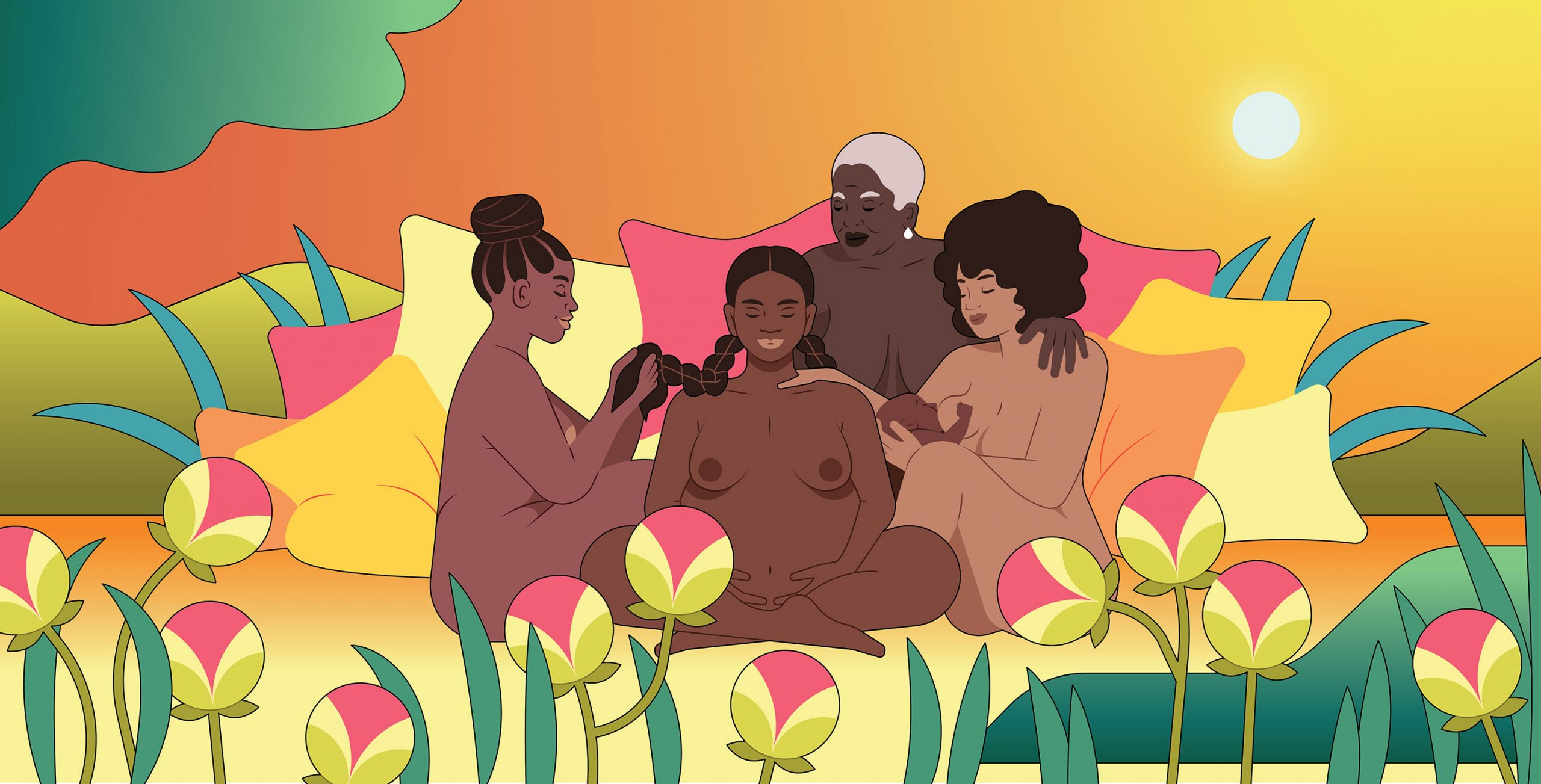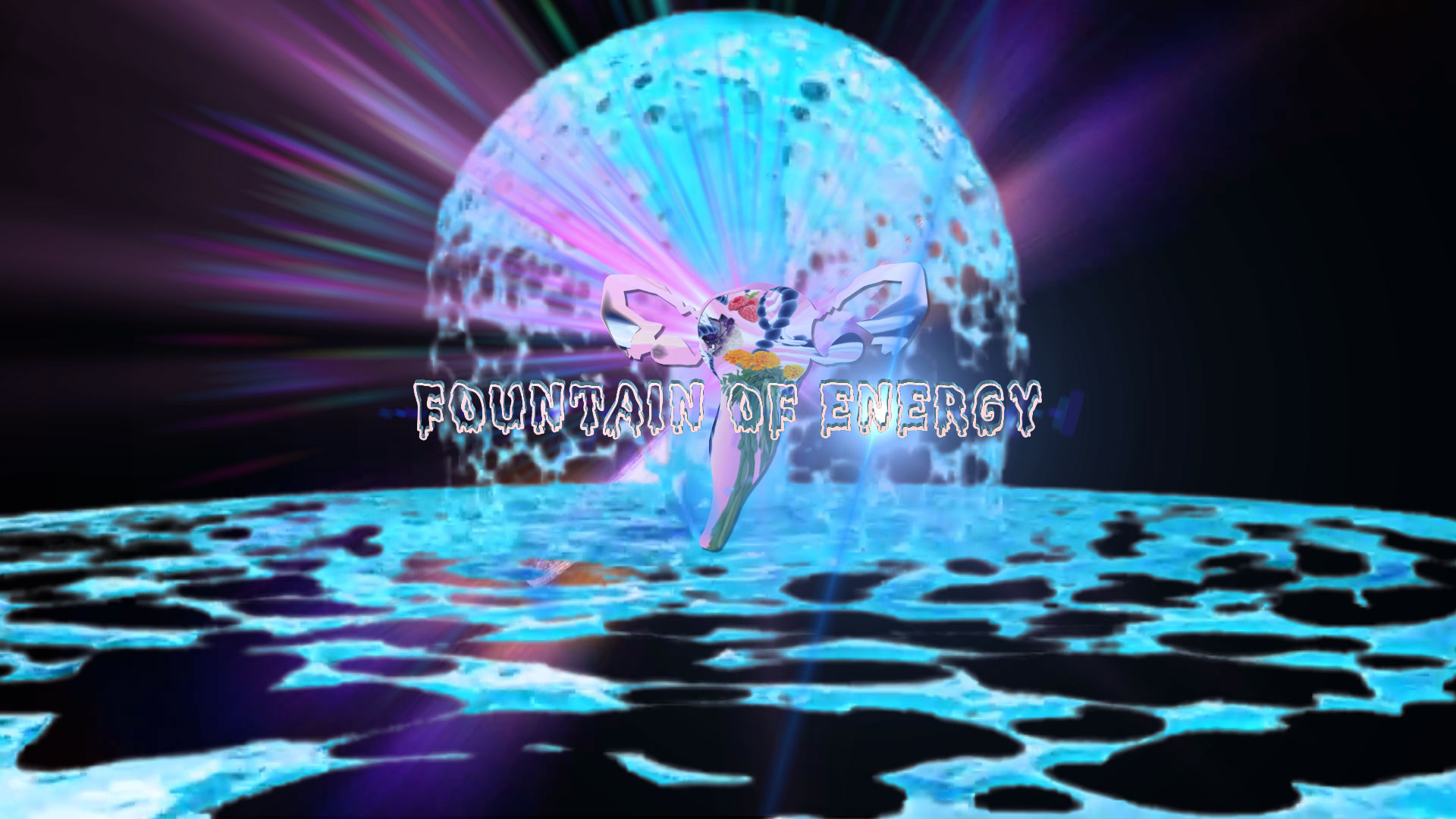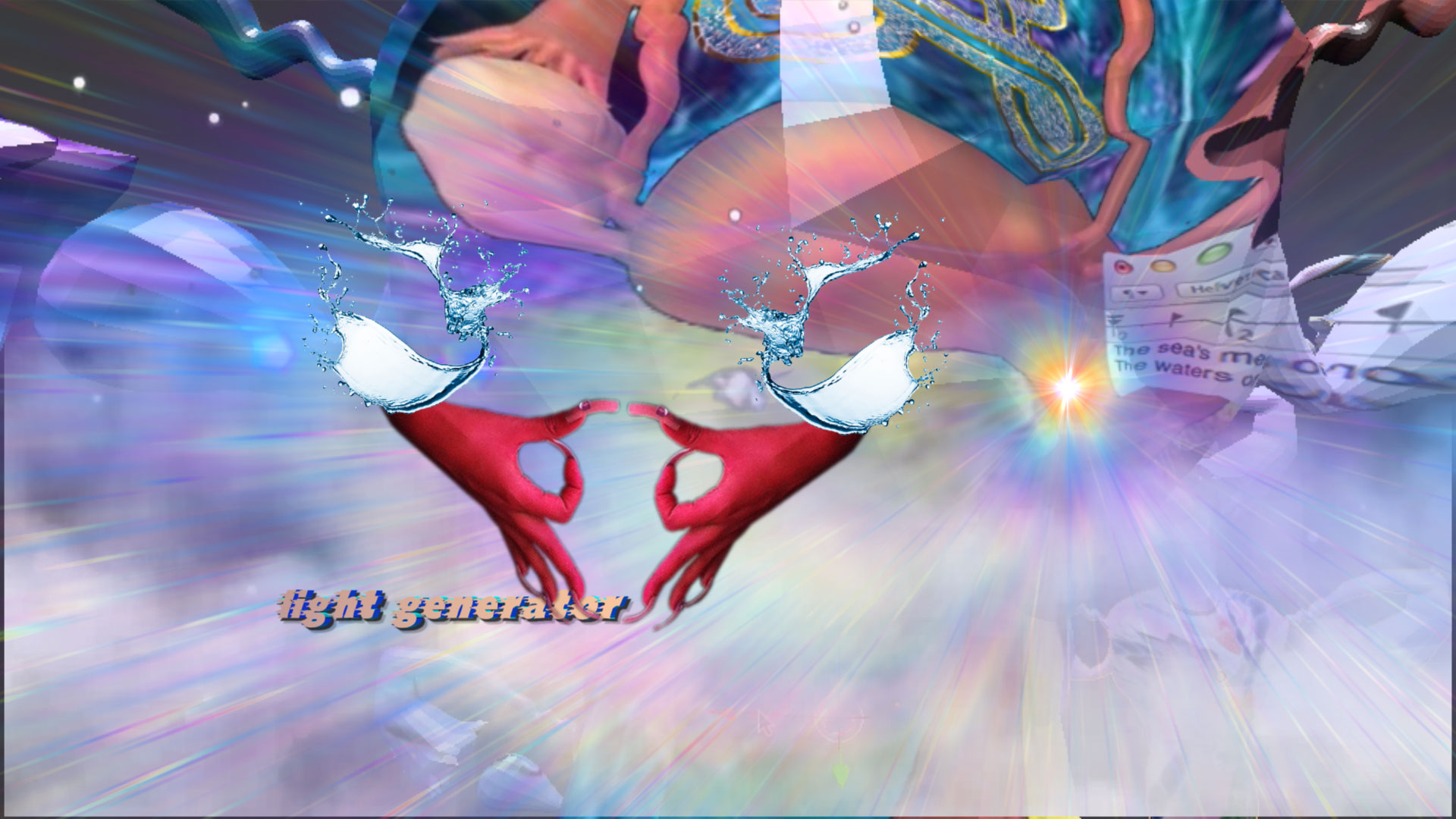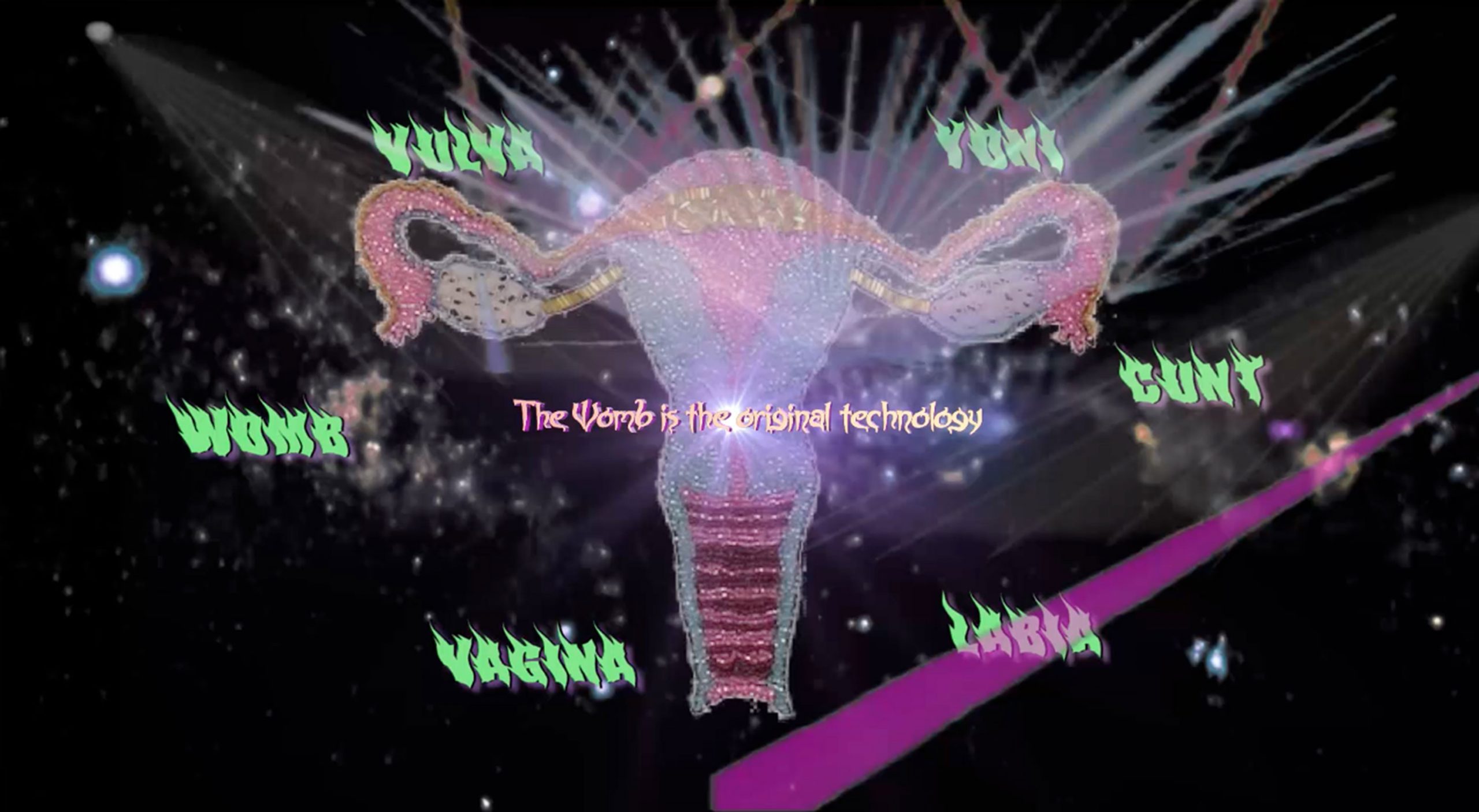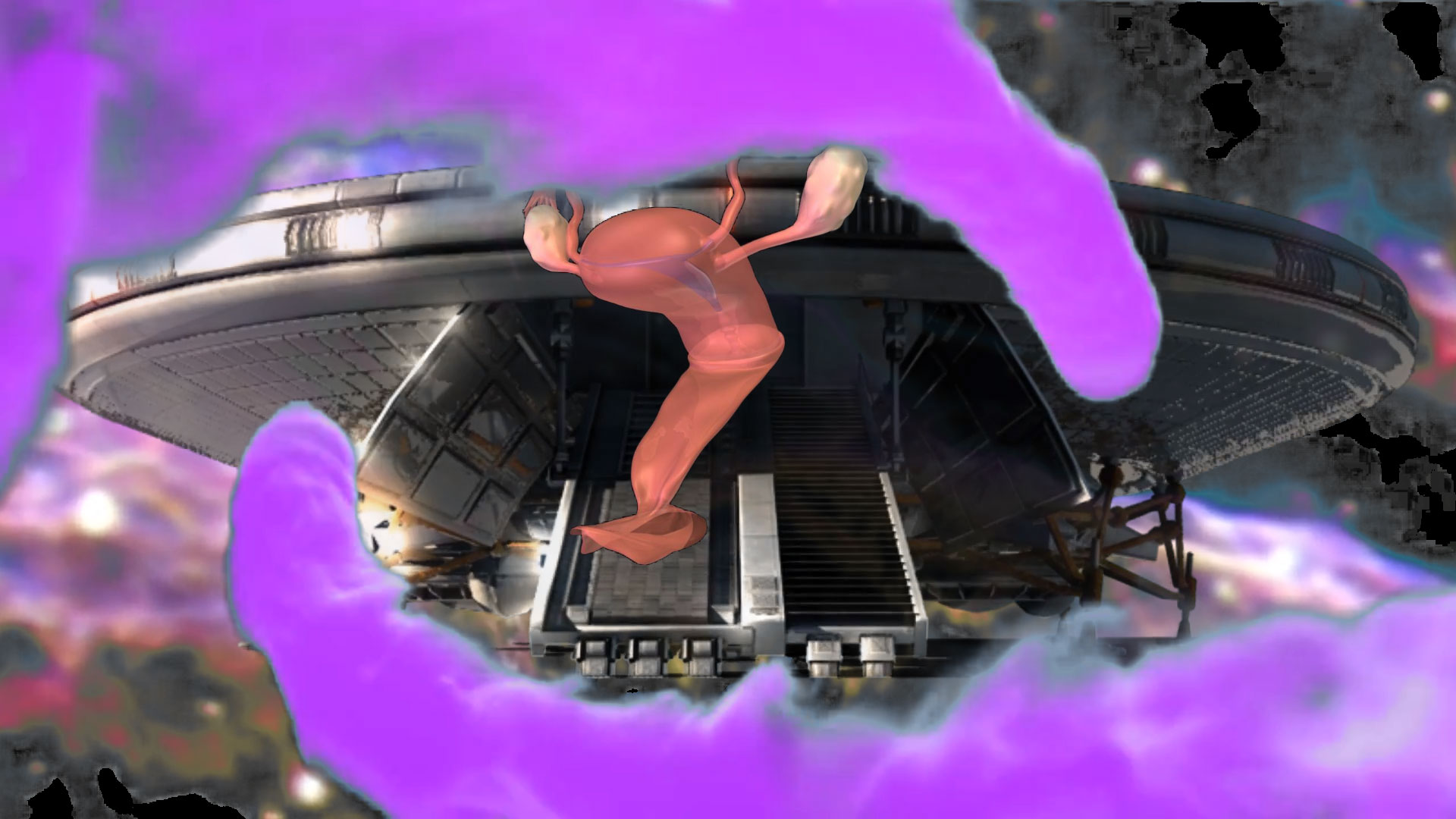Tabita Rezaire’s essay “On Birth” is a meditation on the plurality of birthing, an “act of creation par excellence.” Through providing frameworks of biology, epigenetics, ancestrality, spirituality, politics, culture, civilization, and more, Rezaire challenges the colonization and power structures surrounding birth with nuanced, inquisitive examples and interrogations.
Rezaire’s interdisciplinary and cross-dimensional practice is embedded in the nexus between the digital, the corporeal, and spirituality. Through her screenings and offerings, Rezaire extends an invitation to resistance, healing, and transformation.
We have all been birthed. We all come from the portal of the womb.
I’d like to offer a decolonial vision on birth. As birth is the most crucial technology. How do we birth each other, our communities and the world we want to be a part of? Birth is the art of creation per excellence. The universe itself was birthed somehow and we keep birthing it with each of our thoughts, words and actions. Yet our global cultures do not pay much attention to the art of birthing.
How we come into the world may determine in some way who we become? We rarely think about the implications of this at the scale of a generation?
We have become a civilisation that do not know how to birth. Neither do we know how to die. Both extremities of life are neglected and feared yet these thresholds of existence are powerful potentials. We have much to learn about life itself exploring the complex and divine process of birth. Here are some glimpses of the social, cultural, political, environmental and spiritual dimension of birth and why it matters, not just for women, mothers but for all of us. As we have all been birthed.
Bacteriology
We have more bacteria within us that we have human cells – 10 to 1. We could say we are more bacteria than human. Yet we don’t know much about the microbiological world – maybe we never had the humility to make ourself small enough to see the significance of life at that scale. We have mainly developed a fearful relationship towards micro-organisms: 8 bacteria, viruses, fungi, algae… and labelled them as a threat. Some definitely are, yet the war on microbes 9 – encouraging a billion $ industries of antibiotics and household products harmful to our lungs, lands, and water systems, depriving our environments of bacterial life – could well also contribute to our ill-health. As the current enthusiasm for microbiome research seems to show, these life forms could well be the guardian of our health. Today, there is much discussions about the gut microbiota, the bacterial ecosystem inhabiting our intestinal track. The composition of this microbiome has been shown to affect our digestion, immune responses, predisposition to stress and other diseases, as well certain cerebral functions. Their influence is so profound. The types of microbes inhabiting our inner lands either benefit our health or impact on it, so it’s central that we nurture this ecology. The gut is the second brain, has been on the tongue of many cultures throughout time. Many indigenous cultures and countless spiritual paths have always insisted on food being medicine, which in other words may also mean the practice of feeding your community of micro-organisms properly so the interspecies cohabitation of our beingness is harmonious and conductive to our well-being. If you serve them, they serve you.
We first acquire our microbiome from our mother at birth, during delivery in the birth canal and through breast milk. The mother has a key role to play in the development of the child’s microbiome. This is crucial to understand that parental transmission goes beyond genetic memory. The mother shares an extra layer of bacteriological memory. How beautiful it is that we potentially carry within ourselves a long lineage of microbes from our distant maternal ancestors. Although the microbiome is a dynamic environment and changes with our diet, exposure to environments and medication intake. So even if we are born out of C-section and/or not breastfed it is still possible to gather a beneficial colony in our microbiome at a later stage.
Beyond the mother’s direct bacteriological terrain, the other bacterial gift one can give a child at birth, is the privilege to be born in a familiar, microbe rich environment, namely the mother’s home. This is in no way to support the ‘natural birth’ ideology but simply to mention that from a bacteriological perspective, one’s home is such a place where the mother has developed anti-bodies for the microbes inhabiting the milieu. As the mother transmits these antibodies to the child, when born at home the child is blessed with a bacterial diversity which will develop their immune functions and support other systems.
Unfortunately (bacteriologically wise), the hospital being a sterile environment, much children do not have access to familiar bacteria at birth and one could say that we are birthing a bacteria deprived generation.
The prejudice held upon microbes is really a consequence of our ignorance. Actually, some have led to radical transformation of our evolution as species. The placenta came into existence, marking the shift from laying eggs, following the contamination of a protomammal with an ancient virus, 10 whose DNA merged with the host’s to give new genetical potentials.
It is time we treat our ecosystems, both within ourselves and the ones we inhabit with respect and honour the diversity of existence. This is in no way incompatible with our survival. The colonial matrix and its legacies have distorted our worldview, placing the human life (the white human life) above all other life forms, legitimizing the extermination and domination of many lives – microorganisms included. Yet, we are but one life expressing itself in different forms. Our survival depends on our collaboration and cohabitation.
Epigenetics
The field of epigenetics can tell us a lot about the power of birth.
Epigenetics is the science that studies the effect of the environment on the expression of our genome. Our intra-uterine life, the way we are born and our early days are crucial in our development as human beings. The exposure to certain environments or events can repress or activate certain genes without changing our DNA. It seems that epigenetic modulation (which genes is active or dormant) can be transmitted from the mother to the child. So the environments (ecological, emotional, psychological…) of the mother during pregnancy and birth could explain certain genetic alteration in the child with potential long term effects – both positive and negative.
This is something that was traditionally well understood, that whatever the mother experiences during pregnancy will somehow imprint the child in the womb and reflect later on. That’s why the community would seek to protect the wellbeing of an expecting mother, trying to uplift her spirit and preserve her from worries. Not for her sake only but to make sure she grows a life that would in turn serve back the community.
The mother was encouraged to maintain a vibrant energy to ignite her life force and that of her child. We harness our vital energies from the elements: earth – the food that we eat, the water we drink, the air we breathe, fire – the exposure to sunlight. The more in tune we are with the elements the more in tune we are with ourselves because the elements make us, they are the building blocks of our whole cosmos. A mother is in a way a vessel for the cosmos to expand and keep creation in motion. As such her responsibility is enormous.
In Yoga it is said that the mother is the first teacher. Maybe the womb is the first university?
It is definitely where we first learn about life. We gather information and memory from the world through our mothers. As embryos we are bathing in the amniotic fluid which depends on the inner chemistry of the mother regulated by her state of being, potentially also conditioned by her ancestors’ experience of life. Epigenetic is transgenerational.
Ancestrality
We carry within us somehow the environments and experiences of our ancestors. We are the consequences of our ancestors’ lives. We are because they were. They live in us. They breathe through and dance with us. They gave us life. Or rather they passed the gift of life forward from the unknowable source of life. With it, they also passed on their pains, sufferings, challenges, gifts, talents, and visions. We are often untangled with our ancestors, trapped in sticky patterns or pulled back in their unresolved dramas. That may be a way to bear witness to some past event, making it visible in the system through some symptoms or challenging situations. The desire to belong to our family, our lineage, or our community, will make us hold onto their suffering as a part of ourself. We are loyal to our ancestral pains. Almost as if letting go of their suffering would be a betrayal. Sometimes the pain we’ve experienced gives us sense of identity, it becomes who we are and it’s frightening to imagine ourself beyond this. We must work on disentangling our relationships with our ancestors, so they can become the resources that they are instead of the trap they can be. We can say ‘ I see your pain. I honor it and leave it with you.’
This happen with births. Sometimes several generations will repeat a way of coming into the world. If we have access, it’s great to ask how we were born, and even how our mothers were born. If these were pleasant experiences, we can call upon these resources or cut the loyalty otherwise. We can love and honor a parent, grandparent, ancestor without needing to reproduce their lives. It is possible to liberate ourselves from the weight of history. Our ancestry reaches far back until the horizon of spacetime. It is certain that they have been blissful experiences of birthing, harmonious families, loving mother-child relationships. They have been people who have stood up for themselves and their communities, who have realised their dreams, who have courageously survived the worst and who have known the power of love. Call upon them for support and guidance. We have access to our transgenerational gifts.
Physiology
The woman’s body 11 is designed to give birth. So why is it that for many birthing a child is terrifying, painful, traumatic or even life threatening? There are numerous reasons to this but one answer could be that we don’t understand the physiology of birth. Birth can be easy and quick, even orgasmic. It is always intense but it needs not be excruciating.
The play of hormones is crucial in the birthing process: oxytocin, endorphins, adrenaline, melatonin… yet the need the right context to take over.
Oxytocin is the hormone of love; it is also responsible for the opening of the cervix and the ejection of the child. Yes, birth is an ejection reflex, like the release of sperm and breastmilk, which are also controlled by oxytocin. Today most women giving birth at the hospital are given synthetic oxytocin because their body do not secrete enough of it. Why is that? It has been found that oxytocin is secreted when the neocortex’ activity decreases. The neocortex is the part of the brain that differentiate us from other mammals, so when we birth, it must shut down so we can tune into our animal nature! It’s no time for logic or reasoning, women must leave Earth and travel to another planet to birth. Oxytocin is that hormone that flies you off to the birthing planet. To support the physiological release of oxytocin, a person giving birth must be protected from all stimulation of the neocortex. What stimulates the neocortex? Language, light, and feeling observed. Basically, everything that brings you back to earth while you re supposed to be on your own planet. It is not surprising that most women are not able to produce enough oxytocin surrounded by unknown doctors and bright hospital lights. The other key hormones are endorphins- the natural pain killers. Endorphins should flush the body during birth so the woman does not experience pain. Here again that is not the reality for most women as their bodies do not secrete enough endorphins, and often rely on are synthetic endorphins: the epidural. What prevents the release of endorphin? Adrenaline, the stress hormone. When experiencing stress or fear we release adrenaline, which blocks the release of oxytocin. Yes, it is hard to relax and stay calm when birthing a human being but the less external stimuli the better you can go inward and guide your baby out one contraction at a time. Also, both oxytocin and adrenaline are contagious, meaning that if someone is stressing around a woman giving birth, she will start producing adrenaline too which will block her endorphin secretion. Likewise, if someone is in a blissed-out state, they will release oxytocin, which will assist the mother to produce more oxytocin. We should really take this into consideration as most health workers are exhausted, overstressed and can contribute to further stressing the mother. The medicalization of birth has provided much support and saved many lives when confronted to a critical or pathological pregnancy. Yet most women do not need a medical birth. Unfortunately, it is very easy to make a birth difficult, and the conditions we are in while we birth can sometime slow or jeopardize the process, when the condition do not support the physiological magic of the body to operate.
More generally, today’s world is ruled by adrenaline. We are all stressed and stressing each other. What kind of world can we birth like this?
Culture
The body’s wisdoms are deep. All mammals on earth have the power to birth their offsprings, and humans are no different. Yet it’s like our world has stripped away this power from mothers, making us all believe they cannot birth their children on their own. Today you need doctors, midwifes, doulas, partners, and preparation classes to give birth to a child? Well the physiology of birth shows us that we don’t need nobody, the body knows. It is the fear surrounding birth that has created and fed this helplessness. It seems that in the Neolithic, women would leave the clan and isolate to give birth. It is with the domestication of nature and animals, the beginning of agriculture, that the process of birth was socialized. It became a cultural event. Spirituality, religion, politics, science and other systems, all had something to say about how to birth. That’s how different cultures around the world developed various traditions and practices to support the birth of a child – sometimes it did, sometimes not. The movement away from physiological birth is not merely an issue of patriarchy or modernity alone, it’s wider than the medical industrial complex, it is a cultural issue. As a culture we believe women cannot give birth on their own, that they do not have that power, that wisdom. This is not to deny the comfort of community or loved ones at this time but when you study the physiology of birth, hormonally speaking, a birthing person needs as little disturbance as possible. This is far from what we offer our mothers currently. Even the ‘natural birth’ movement does not always honour the innate capacity of the body to birth.
Spirituality
Birth is a spiritual event, a meditation on creation, a miracle of existence. If you’ve seen a child coming out of a woman you know life is an incredible phenomenon. That a tremendous intelligence is at play, expressing itself through us.
We are both matter and spirit. Creating a life happens on both planes. The mother is responsible for growing the material shell that will be the spirit’s vessel while on earth. In yogic philosophy it is said that the spirit or soul enters the womb on the 120th day after conception. The state of awareness of the mother will attract a certain life to embody her womb, one that will benefit (on a spiritual level) from this specific family, geography, time and context. After the soul enters the body, the mother has the power to impact the life within her as whatever she thinks, feels, and does, imprint the child’s subconscious. This is why yogic sciences recommend women to meditate, sing, and dance a lot while pregnant. Who can meditate for 9 months these days?
Even if people could, rare are those who would, as we have lost the reverence and devotion to the process of life making. As a culture we reward productivity, so devoting 9 months to cultivate a state of inner bliss so as to give the world a conscious child is no one’s priority. It may even sound like a step back to what women have achieved in terms of freedom and emancipation, yet we must understand the responsibility that it is to bring a life on earth. We are creating the next generation. People always talk about what kind of planet will we leave to our children but we should also think about what kind of children we are leaving to our planet.
Spirituality means union, it is the art and science of becoming one with life. It is total inclusivity. The spiritual path is the journey towards experiencing oneself beyond the limit of the body and the mind, so as to experience our limitlessness. To break free from the illusion of separation. When you grow a child within yourself that is such a moment when two people merge and one can experience the union between two lives. That is a gift! If we can experience union with all lives – human, animal, vegetal, mineral, ancestral, alien – then we’re liberated. But the privilege to nurture this union within oneself during pregnancy is a tremendous opportunity for spiritual growth.
Also, if it was not for their children, only a few people would experience that level of devotion within themselves, that level of patience and the power to sacrifice! Those discipline that spiritual seekers self-impose through their practice, are available to mothers and parents. Those are the hard-learnt gifts of motherhood.
To mother is a spiritual practice.
Politics
Today’s capitalist and patriarchal agenda barely allow us to honor the wisdom of birthing. The industrialization of birth, the masculinization of birth, the medicalization of birth, the control of birth, all alter the physiological and spiritual process of birth giving.
Although a lot of reproductive justice advocacy has helped to bring awareness to obstetrical violence, we are very far from a place where a person can safely expect to be supported, listened to and care for during the transformational journey into motherhood.
Black women are even more prone to abuse by the medical system, and the number of deaths in birth are much higher for black women. Already at birth we are not all treated equal when coming into the world. The racial disparities are frightening.
The doula movement is partly trying to answer the cries of mothers seeking support. Yet It is also very much a matter of class and privilege. Who can afford to have a ‘natural birth’? Who can afford the cost of a doula? Who can afford long term breastfeeding? Who can afford to stop working to decrease stress levels during the pregnancy? Who can afford prenatal or postnatal yoga? Who can afford to stay at home to care for their new born? Who has access to a support network to mother the mother after birth? A few.
We have built a world where no thought is given on the primal period of intrauterine life and postpartum.
If we really want to serve the world we exist in, to participate in the struggle for decolonization and the birth of a decolonial reality, we must radically transform the way we support expecting mothers and care takers. I plant the seed for a next generation in tuned with the earth, with all species, with themselves, with spirit to come out of our wombs because we would have had the privilege to grow them in love and devotion supported by a system that protects women, children and all lives.
Civilisation
As a culture we must respect the creation of humanity, and ensure we are birthing a generation better than our own. Only if we put attention and intention in the act of birthing will we raise human beings more capable than we are. That is a decolonial project, that is the decolonial project. To raise our consciousness, to evolve beyond the trap of greed, domination and violence. The spread of patriarchy enforced a global contempt of the feminine, yet we all come from a womb. As our cultures so blatantly disregard its source as shown by the ravage of rape culture, feminicide, forced sterilization, birth control, and other gynecological violence…it is not surprising that we so easily disrespect the earth. The womb of the earth is where we all come from. The earth gave us our body. The earth nourishes us, feeds us, cares for us, as does a mother.
We must urgently ask ourselves what we have done to our world? What we have done to ourselves? To our mothers? And prepare as we may be entering a whole new horizon with artificial wombs. What kind of humanity will we give birth to then?
Thinking about birth is crucial for our civilization, for our survival, for our thriving, for our growth, for our hearts and spirits.
May we honor the lineages of the wombs we come from. The cosmic womb, the womb of the earth, the womb of our mother.
Ashé
Tabita Rezaire is infinity incarnated into an agent of healing, who uses art as a means to unfold the soul. Her cross-dimensional practices envision network sciences—organic, electronic and spiritual—as healing technologies to serve the shift towards heart consciousness. Navigating digital, corporeal and ancestral memory as sites of resilience, she digs into scientific imaginaries to tackle the pervasive matrix of coloniality and the protocols of energetic misalignments that affect the songs of our body-mind-spirits. Inspired by quantum and cosmic mechanics, Tabita’s work is rooted in time-spaces where technology and spirituality intersect as fertile ground to nourish visions of connection and emancipation. Through screen interfaces and collective offerings, she reminds us to nurture each other, the earth, spirits and to download directly from source.
Tabita is based in Cayenne, French Guiana. She has a Bachelor in Economics (Fr) and a Master of Research in Artist Moving Image from Central Saint Martins (Uk). Tabita is a founding member of the artist group NTU and half of the duo Malaxa. She is currently birthing AMAKABA, her vision for a healing center in the Amazon forest of French Guiana.
Tabita has shown her work internationally – Centre Pompidou Paris; Serpentine London; MoMa New York; New Museum New York; Gropius Bau Berlin; MMOMA Moscow, Museum of Contemporary Art Chicago; ICA London; V&A London; National Gallery Denmark; The Broad LA; MoCADA NY; Tate Modern London; Museum of Modern Art Paris – and contributed to several Biennales such as the Guangzhou Triennial, Athens Biennale, Kochi Biennale in 2018, Performa and Karachi Biennale in 2017 and Berlin Biennale in 2016.
Anna L. Tsing, The Mushroom at the End of the World, 2015↩
Le Guin positions the container, rather than the spear, as the first human tool, following the writings of Elizabeth Fisher. Ursula K. Le Guin, The Carrier Bag Theory of Fiction, 1986↩
In “On Non-Scalability,” Tsing establishes that a primary critique of scalable frameworks is of their inability to maintain diversity. Taking that intrinsic flaw into account, we aim to not promote the amplification of a singular feminist framework. Anna L. Tsing, “On Non-Scalability,” 2012↩
In an interview with Jorge Cotte, Wendy Hui Kyong Chun states, “Every form of communication is based on a fundamental leakiness.” These leaks can be seen as moments of possibility. Wendy Chun, “Reimagining Networks,” The New Inquiry, 2020↩
Anna L. Tsing, The Mushroom at the End of the World, 2015; Anna L. Tsing, Roxana Fabius, Patricia M. Hernandez, Mindy Seu, “Big histories are always best told through insistent, if humble, details,” The Scalability Project, A.I.R. Gallery, 2020↩
In Glitch Feminism, Legacy Russell sees the glitch as a catalyst rather than an error, a “correction to the machine.” Legacy Russell, “Digital Dualism And The Glitch Feminism Manifesto,” Cyborgology, 2012↩
Here we are drawing from Judy Wajcman’s definition of interpretive flexibility. Wajcman describes technology’s malleable character, emphasizing that there is nothing inevitable about the way technologies evolve. Users have the power to radically alter technologies’ meanings and deployment. Judy Wajcman, TechnoFeminism p.37↩
Micro-organisms: there is debate in the scientific community as to whether viruses are alive or not, as they cannot survive without a host. Hence for some they do not fall under the term micro-organism.↩
microbes: in biology the term is equivalent to microorganism but commonly speaking a microbe is a harmful micro-organism, as in harmful to humans.↩
Avir Mitra, How the placenta evolved from an ancient virus, 2020↩
Wanting to acknowledge trans women here. Not all women have a womb.↩
